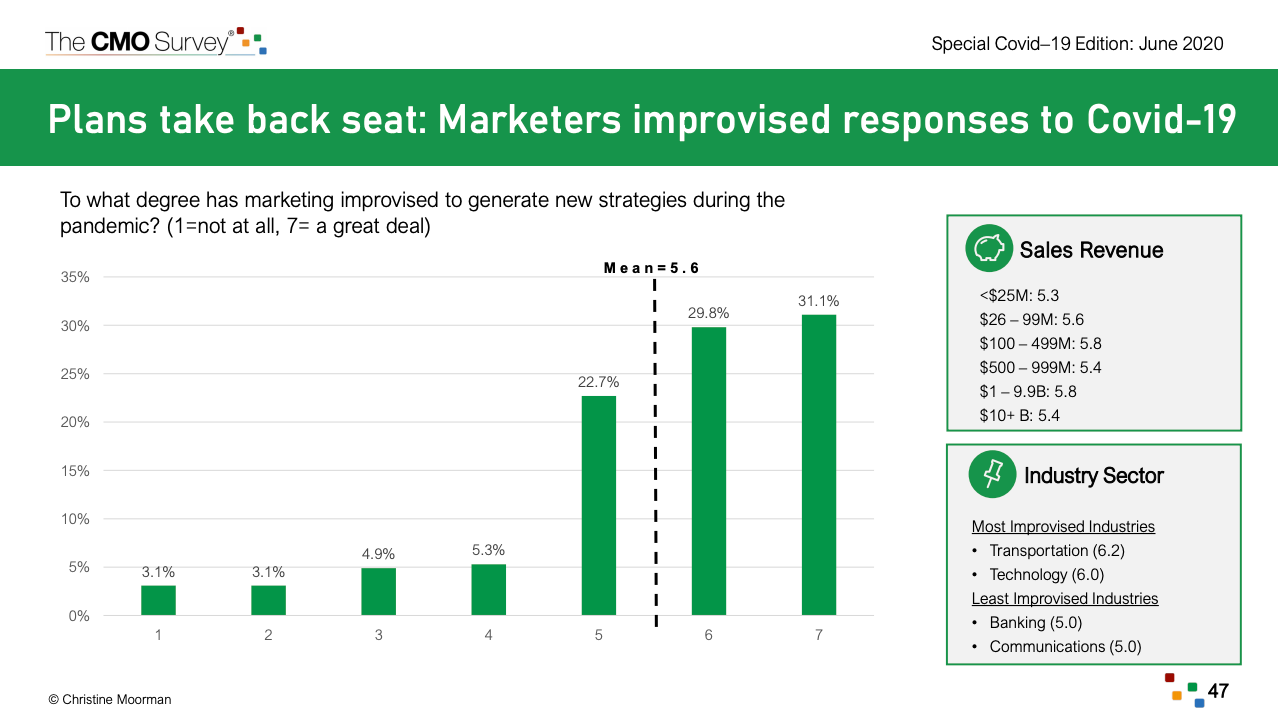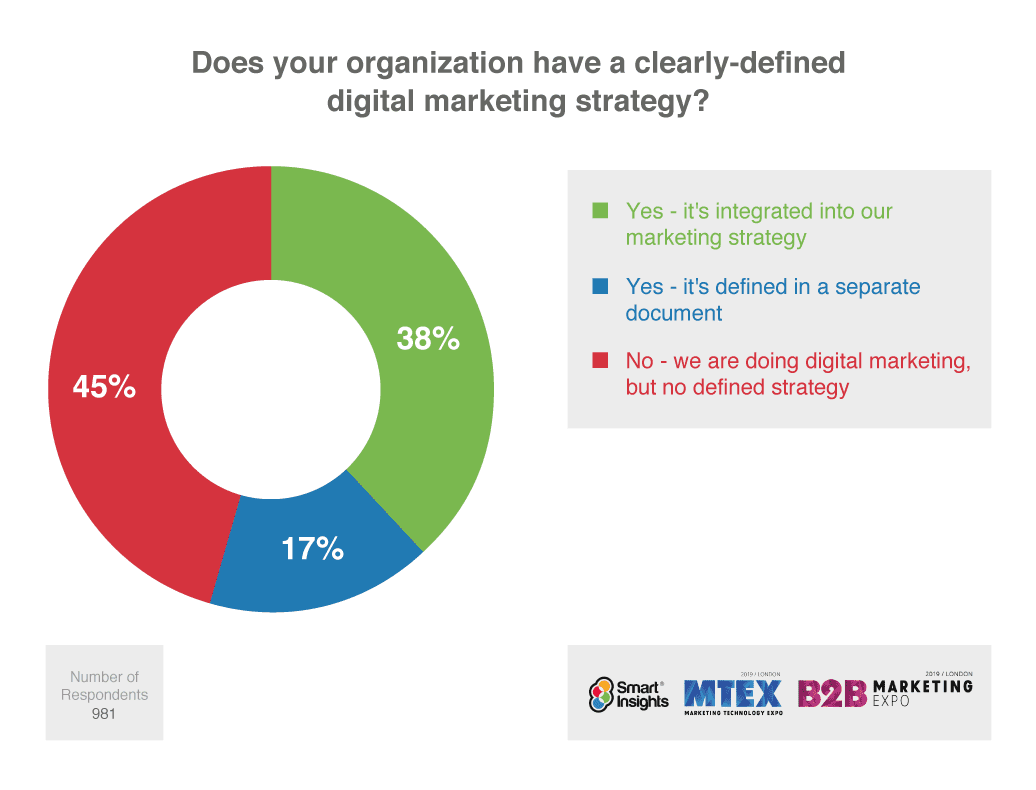The latest results from the CMO Survey, a special COVID-19 edition, give a fascinating insight into our fellow marketers' business strategy and planning to drive growth this year.
Digital Marketing Strategy during COVID-19
84% of marketers confirm they have ‘improvised to generate new marketing strategies during the pandemic’ according to the CMO Special Covid-19 report in June 2020. So what did they do? And what can we learn about managing business growth right now?
“The measure of intelligence is the ability to change”
- Albert Einstein
So, by Einstein’s prognosis, 2020 has been a very intelligent year for marketers. While for some of us, the changes have been less grand, others have witnessed a complete transformation in less than half a year. Naturally, there are fluctuations by industry, so for more detailed data about your industry, check out this special Report of Results by Firm and Industry Characteristics.

Here at Smart Insights, we've released a special free guide for marketing planning in the midst of rapidly changing consumer spending and demand for products and services, structured by the RACE planning framework.
- Plan - defining your marketing communications strategy and action plans
- Reach - growing awareness and demand
- Act - generating leads using the best content and customer journeys
- Convert - increasing both online and offline conversion to sale
- Engage - improve loyalty through customer communications
This free guide contains a checklist of 45 ways to maintain leads and sales during a market downturn.
Download FREE Member resource – Recession-beating marketing tactics for growing your business
With changes in consumer in consumer spending, it becomes vital to rapidly think through new alternative approaches to prioritize marketing activities with the biggest potential. That’s where this guide aims to help, by presenting a checklist of 45 ideas to review.
Access the
Marketing models for growth
We use marketing models to inform our strategy and planning, and planning during a recession is no different. In fact, the beauty of marketing models for growth is that they can be applied in any environment where growth is the priority.
"As our marketing activities adapt to emerging contexts so these models provide a sound basis on which we can learn, relate and develop suitable strategies and tactics to help us manage in these new environments"
- Chris Fill
With the landscape as it stands, there are 2 marketing models for growth which stand out for adding significant weight in driving business growth in 2020. Interestingly, the results from the CMO survey suggest that many marketers are already applying these theories to their improvised COVID strategies.
In his guide, Creating a marketing action plan for a recession, Dr. Dave Chaffey advises marketers looking for growth (or just to keep afloat) to 'tap into your existing customers as your biggest asset to encourage repeat purchase AND new purchases'. In marketing model land, this signifies a big thumbs up for the Customer Lifecycle.
In the meantime, spending on growth during 2020 has shifted to reflect the fast rate of change in customer needs. Where possible, many businesses have experienced growth through diversification. Diversification being one quadrant of the ever-popular Ansoff Matrix (more on that below).
Customer Lifecycle Marketing Model
Hopefully, your digital marketing strategy already pays heed to the power of customer lifecycle marketing. Need more convincing? The numbers back it up: a 5% increase in customer retention can increase company revenue by 25-95%.
It’s no surprise that 2020 signals a golden era for the Customer Lifecycle, offering bang for your buck when you need a sure thing. The CMO found 77% of businesses prioritizing ‘Retaining current customers’ in their top 3 objectives during the pandemic.
By focusing on customer retention, businesses can achieve continued sales at a lower ROI, as demonstrated by the Customer Lifecycle.

As a starting point, you can plan and prioritize your digital transformation around the RACE planning framework. Consider the role of digital communications across the Customer Lifecycle. As you can see in the infographic, taken from our Digital Transformation Playbook, the Reach Act Convert and Engage customer journey is punctuated by digital experience and paid, owned and earnt media omnichannel options.
Outpace your competition in a challenging SME market
Access a complete marketing survival kit to grow your business during a recession
Get Results, Fast
Ansoff Matrix Marketing Model
Diversification is the name of the game in 2020 and marketing managers know this golden opportunity for growth can be classified within the Ansoff Matrix. In fact, 42% of businesses have shifted resources to 'new products and offerings' in response to the pandemic.
A timely focus on diversification demonstrates a shift in priorities compared to similar research on business growth reported in August 2018, when more than half of the growth spend was allocated to market penetration.
As recently as August 2019, the CMO reported that only 10% of the total Ansoff Matrix growth activity was allocated to diversification.

Now in 2020, nearly half of businesses have shifted resource to diversification. So the implication of this shift within the Ansoff Matrix is a modified, innovative growth strategy for marketers wanting to grow their business in a changing landscape.
Digital Transformation for growth
The CMO survey reported that 85% of businesses have observed increased customer openness to new digital offerings whilst 84% observed increased value placed on digital experiences during the pandemic.
It’s no secret that, as champions of Digital Transformation, Smart Insights team members help businesses achieve growth through Digital Transformation every day. Our latest digital benchmarking report found that as many as 45% of businesses do not have a digital marketing strategy, which means nearly half of businesses are missing out on benefits including:
- Growth of market share
- Granular audience development
- Effective allocation of digital marketing financial and workload resources

With this CMO report, marketers are handed their Digital Transformation business case on a plate. Now is the optimum time to transform your business and grow your customer base.
In May 2020 more than 4/5ths of businesses observed increased customer openness to and value placed on digital offerings/experience.

Your Digital Transformation plan
Incorporating Digital Transformation into your objectives is strongly recommended for a strategy that drives growth in 2020. But what does a Digital Transformation plan look like?
- Understand the channel.
- Set objectives for future channel contribution.
- Identify and prioritise target audiences.
- Encourage usage of the channel.
- Create propositions to emphasize the differences.
- Support integration between channels.
- Review how competitors use the channel.
- Develop channel partners.
Find out more about Digital Transformation with our dedicated Toolkit, filled with resources including our Business Case Template, Managing Digital Transformation Guide, and Digital Transformation Playbook for Business Members.
If you've experienced a fluid marketing strategy over the last few months, you're certainly not alone. Hopefully, these models will provide a framework for your forward planning. Nobody is predicting the end of the pandemic anytime soon, and as things change of course we will be required to continue to shift. Both the Customer Lifecycle and Ansoff Matrix have the flexibility to support that.
Finally, to get it all kicked off, if you do need any assistance with your Digital Transformation or any other aspects of Business Membership we'd love you to get in touch.






















